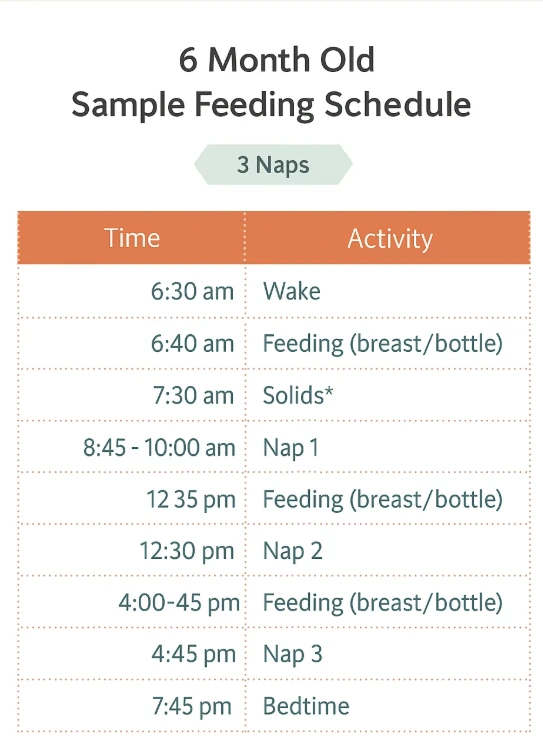Taking Cara Babies 6 Month Schedule: A Complete Guide for Restful Baby Sleep
When your baby turns six months old, sleep begins to take a more consistent pattern, though surprises still happen. The Taking Cara Babies 6 month schedule helps parents create a calm rhythm that balances naps, feeding, and bedtime without pressure to follow a rigid plan. Every baby is unique, and this gentle structure encourages flexibility. By understanding your baby’s sleep cues and natural wake windows, you can help build habits that support smoother days and more peaceful nights.
Understanding the Six-Month Sleep Pattern
At this stage, your baby’s internal clock starts developing a clear routine. It becomes easier to predict sleep and feeding times when you observe signs of tiredness such as eye rubbing, yawning, or less active play. Babies thrive when their bodies and minds follow a balanced rhythm. Most six-month-olds need around three to four hours of daytime sleep and about eleven to twelve hours at night. Keeping a consistent schedule reduces crankiness and helps your baby fall asleep faster.
Ideal Sleep Guidelines for Six Months
Below are general guidelines that can help you build a strong foundation for your baby’s sleep routine:
| Sleep Element | Recommended Range | Why It Matters? |
|---|---|---|
| Daytime Feedings | Every 2.5 to 3.5 hours | Keeps energy steady and supports nap consistency |
| Total Daytime Sleep | 3 to 4 hours | Promotes restorative rest and better nighttime sleep |
| Ideal Bedtime | Between 7:00 and 8:00 pm | Helps prevent over-tiredness and late-night fussiness |
| Number of Naps | 2 to 3 | Smooth transition from 3 naps to 2 between 6.5–7 months |
| Wake Windows (3 naps) | Around 2 to 2.5 hours | Supports healthy sleep pressure and longer naps |
| Wake Windows (2 naps) | Around 2.5 to 3.5 hours | Encourages deeper, more restorative rest |
Use these numbers as flexible markers, not strict rules. Always respond to your baby’s needs first because every child develops at a slightly different pace.
Sample Daily Routine for a Six-Month-Old

While every family’s lifestyle is unique, these sample schedules provide a general structure you can adjust based on nap length and feeding preference.
Example with 3 Naps
| Time | Activity |
|---|---|
| 6:30 AM | Wake up and feeding |
| 7:30 AM | Solids if introduced |
| 8:45–10:00 AM | First nap |
| 10:05 AM | Feeding |
| 12:30–1:30 PM | Second nap |
| 1:35 PM | Feeding |
| 4:00–4:45 PM | Third nap |
| 4:45 PM | Feeding |
| 7:15 PM | Final feeding |
| 7:45 PM | Bedtime |
Example with 2 Naps
| Time | Activity |
|---|---|
| 7:00 AM | Wake up and feeding |
| 8:00 AM | Solids or light breakfast |
| 9:45–11:30 AM | First nap |
| 12:30 PM | Feeding |
| 2:30–4:00 PM | Second nap |
| 4:00 PM | Feeding |
| 5:00 PM | Solids |
| 6:30 PM | Final feeding |
| 7:00 PM | Bedtime |
When your baby starts resisting naps or takes longer to fall asleep, it may signal readiness to drop from three naps to two. Be patient during this transition since every baby adjusts differently.
Importance of Wake Windows
Wake windows are the awake periods between naps and bedtime. They gradually lengthen as your baby grows. Shorter wake windows in the morning and slightly longer ones by evening promote smoother sleep cycles. For a six-month-old, aim for about two hours of awake time after the morning nap and closer to three hours before bedtime. Observing your baby’s behavior during these windows helps prevent over-tiredness and supports better-quality sleep.
Nap Duration and Quality
Most six-month-old babies nap for a total of three to four hours daily. The morning nap is often the longest, while the final nap is usually shorter. Try to avoid any single nap lasting longer than two hours because it may interfere with nighttime sleep. Keeping daytime rest under four hours ensures your baby is ready for bed in the evening without becoming overstimulated or overtired.
Creating a Calm Bedtime Routine
A soothing bedtime routine signals your baby that it’s time to wind down. Begin this routine about 30 to 45 minutes before sleep. Activities can include a warm bath, gentle massage, a quiet feeding, and a lullaby in a dimly lit room. Keep the environment calm and avoid screens or loud toys during this time. A consistent bedtime between 7:00 and 8:00 pm helps prevent late-night fussiness and early morning wake-ups.
Handling Sleep Regressions and Changes

At six months, many babies experience short sleep regressions caused by developmental milestones such as rolling, sitting, or teething. You might notice more night wakings or shorter naps. This phase usually lasts two to three weeks. Maintain your routine, offer comfort, and keep the environment consistent. Familiar patterns help your baby feel secure and return to stable sleep quickly.
Feeding and Sleep Connection
Feeding plays a major role in your baby’s sleep quality. Regular daytime feedings every 2.5 to 3.5 hours support steady energy levels and prevent hunger-related wake-ups. Most six-month-olds still wake once or twice for nighttime feeding, which is completely normal. Continue to prioritize breast milk or formula since solids at this age are only for introduction, not full nutrition.
Expert Tips for Healthy Sleep Habits
| Tip | Purpose |
|---|---|
| Follow your baby’s cues instead of the clock | Builds confidence and avoids over-tiredness |
| Maintain a consistent sleep environment | Promotes secure and restful sleep |
| Use white noise or soft lullabies | Helps soothe your baby during transitions |
| Avoid overstimulation before naps | Keeps your baby calm and ready for rest |
| Practice safe sleep on a firm mattress | Ensures safety and reduces sleep interruptions |
Engaging Daytime Activities for Better Sleep
Active and engaging playtime supports healthy sleep. Encourage tummy time, rolling practice, and exploration with soft toys. Sit in front of a mirror together to help your baby recognize their reflection. Read colorful picture books and sing gentle nursery rhymes. These simple interactions stimulate your baby’s senses, support physical development, and encourage sounder sleep.
When to Consider Gentle Sleep Training
By six months, some babies may be ready for gentle sleep training if frequent night wakings persist. Choose a method that feels emotionally comfortable for your family. The goal is not to let your baby cry alone but to teach independent sleep skills through reassurance and consistency. Every child learns at their own pace, so patience is key.
Final Thoughts
The Taking Cara Babies 6 month schedule promotes balance, predictability, and a nurturing connection between parents and baby. It helps families understand natural rhythms while allowing flexibility for daily changes. There is no single perfect schedule; the best one is what fits your baby’s needs and your home routine. By keeping wake windows balanced, naps consistent, and bedtime calm, you can help your baby enjoy deeper rest and steady growth every day. Read more.

